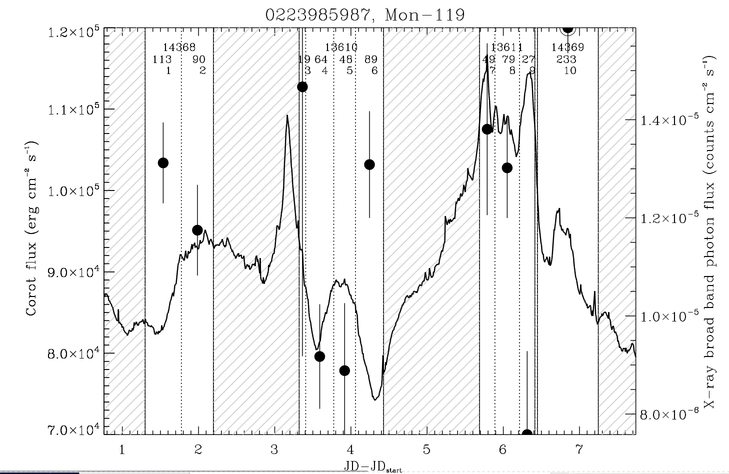Scientific Projects
• The Coordinated Synoptic Investigation of NGC 2264
The Coordinated Synoptic Investigation of NGC 2264 (CSI-2264) is a unique cooperative effort aimed at characterizing the variability of young stars in NGC 2264 (1-5 Myrs) simultaneously from the X-rays to the mid-IR, on timescales ranging from fractions of hours to several weeks. The bulk of the observing campaign was carried out between December 2011 and February 2012 with the CoRoT satellite. Simultaneous observations were acquired with thirteen other telescopes both ground- and space-based. The international team is led by John Stauffer, of the Spitzer Science Center in Pasadena (California).
My role in the project is the analysis of the simultaneous optical (from CoRoT) and X-ray (from Chandra/ACIS-I) observations of this cluster. The analysis of simultaneous optical and X-ray data in young stars, with the high temporal resolution provided by CoRoT and Chandra, can potentially unveil important information on the physical properties of the young stars of NGC 2264.
In stars with disks optical variability is dominated by the presence of the disks. The circumstellar material associated to warped inner disk can in fact obscure the central star periodically or aperiodically, depending on the location of the warps with respect the co-rotation radius (at which disk and star rotate at the same velocity). During the ecplises the luminosity of the star fades away, and colors become more red for the increasing extinction. If the warps also obscure coronal active region, also the X-ray absorption due to the intervening hydrogen column increases.
Stars with disks also accrete gas from the disk. The gas is funneled by the magnetic field lines connecting star and disk in the inner region of the disk, and then it falls on the star at almost free-fall velocity. Accretion can contribute to observed variability in optical and X-rays since hot accretion spots are sources of soft X-ray, UV, and optical emission that can be rotationally modulated. Besides, accretion columns can obscure stellar photosphere and corona, being responsible of variable extinction and X-ray absorption. The analysis of simultaneous optical and X-ray variability in stars with disks can unveil the nature and composition of the material associated with disk warps and accretion columns, the geometry and morphology of the inner disk and the properties of the accretion process.
Variability in young stars without disks is dominated by stellar activity. Spots, faculae and coronal active regions can be responsible for fading of optical emission and brightening of optical and X-ray emission, respectively. Their contribute on the optical and X-ray stellar emission is rotationally modulated, and the analysis of the resulting variability provide information on the properties of stellar photosphere and coronae and stellar activity. Flares is however the dominant source of variability in disk-less stars. The analysis of stellar flares in optical and X-rays allow to estimate the energy released during flares, to study the thermal evolution of confined plasma and that of the magnetic structures which are confining and heating the plasma.
Scientific Products:
- Guarcello et al. 2017. This paper focuses on the simultaneous optical and X-ray variability in stars with protoplanetary disks and the role of accretion and obscuration of the central star.


